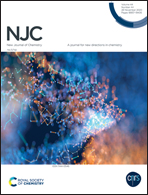One-dimensional polymeric iodoplumbate hybrids with lanthanide complex cations: syntheses, crystal structures, and photoelectric and photocatalytic properties†
Abstract
New iodoplumbate hybrids with lanthanide complexes [La(DMF)8]Pb3I9 (1) and [Ln(DMF)8]Pb5I13 (Ln = Sm (2), Gd (3)) (DMF = N,N-dimethylformamide) were prepared using octakis complex cations [Ln(DMF)8]3+ formed in situ as structure directing agents by volatilizing at room temperature. The polymeric 1-D [Pb3I9]n3n− anion in compound 1 is constructed by PbI6 octahedral units via face-sharing featuring a waved chain structure, while the 1-D [Pb5I13]n3n− anion in 2 and 3 is composed of PbI6 units via both edge-sharing and face-sharing. The compounds 1–3 show steep band gaps at 3.02, 2.61, and 2.57 eV, respectively, indicating potential semiconducting properties. They exhibit catalytic activities in the photodegradation of organic pollutants like crystal violet (CV) and methylene blue (MB). Compounds 2 and 3 are more effective than 1 in the photocatalytic degradation of CV, which are related to their intensity of the photocurrent response. The photocurrent response, cyclic voltammetry measurements and photocatalytic mechanism investigation for compound 2 show that ˙OH radical and h+ hole are the main reactive species in the degradation experiment of CV.



 Please wait while we load your content...
Please wait while we load your content...